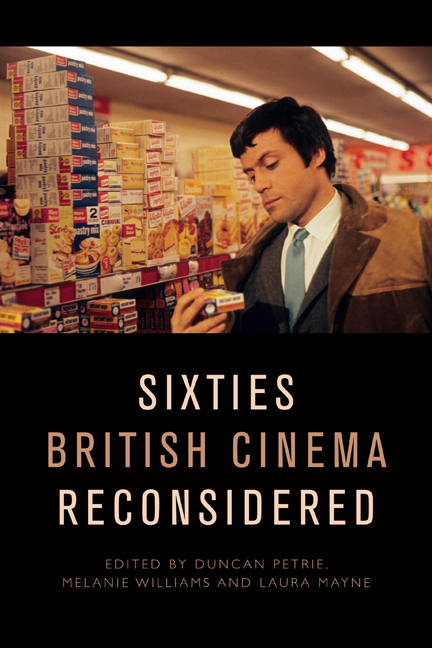Book contents
- Frontmatter
- Contents
- List of Figures and Tables
- Notes on the Contributors
- Introduction
- PART ONE STARS AND STARDOM
- 1 Male Stardom in 1960s British Cinema
- 2 ‘Rebel Rebel’?: Oliver Reed in the 1960s
- 3 Carol White: The Bardot of Battersea
- 4 ‘The Old Wave at Work’: The Transatlantic Stardom of the British Character Actress in the 1960s
- PART TWO CREATIVE COLLABORATIONS
- 5 Woodery-pokery: Charles Wood’s Sixties Screenwriting
- 6 ‘Beyond Naturalism’: Jocelyn Herbert, If . . . (1968) and Design for Performance in 1960s British Cinema
- 7 Kes: From Page to Screen
- 8 ‘I’d like to remember you as you are – as just a grumpy old man’: Joseph Losey and the Making of Figures in a Landscape (1970)
- PART THREE STYLE AND GENRE
- 9 ‘Wholesome rough stuff’: Hammer Films and the ‘A’ and ‘U’ Certificate, 1959–65
- 10 Widescreen Pyrotechnics: Shot Composition and Staging in the Cold War Films of Joseph Losey and Sidney J. Furie
- 11 The Rise and Fall of the Colourful Corporate Fantasy in 1960s British Cinema
- 12 Witchfinders and Sorcerers: Sorcery and Counterculture in the Work of Michael Reeves
- PART FOUR CULTURAL TRANSFORMATIONS
- 13 ‘An Impulse of Anger, Instantly Regretted’: Rebellion and Reaction in the Early-1960s Naval Film
- 14 Narratives of Race and Identity in Sixties British Cinema
- 15 Panic at the Disco: Brainwashing, Alienation and the Discotheque in Swinging London Films
- Index
6 - ‘Beyond Naturalism’: Jocelyn Herbert, If . . . (1968) and Design for Performance in 1960s British Cinema
Published online by Cambridge University Press: 22 September 2020
- Frontmatter
- Contents
- List of Figures and Tables
- Notes on the Contributors
- Introduction
- PART ONE STARS AND STARDOM
- 1 Male Stardom in 1960s British Cinema
- 2 ‘Rebel Rebel’?: Oliver Reed in the 1960s
- 3 Carol White: The Bardot of Battersea
- 4 ‘The Old Wave at Work’: The Transatlantic Stardom of the British Character Actress in the 1960s
- PART TWO CREATIVE COLLABORATIONS
- 5 Woodery-pokery: Charles Wood’s Sixties Screenwriting
- 6 ‘Beyond Naturalism’: Jocelyn Herbert, If . . . (1968) and Design for Performance in 1960s British Cinema
- 7 Kes: From Page to Screen
- 8 ‘I’d like to remember you as you are – as just a grumpy old man’: Joseph Losey and the Making of Figures in a Landscape (1970)
- PART THREE STYLE AND GENRE
- 9 ‘Wholesome rough stuff’: Hammer Films and the ‘A’ and ‘U’ Certificate, 1959–65
- 10 Widescreen Pyrotechnics: Shot Composition and Staging in the Cold War Films of Joseph Losey and Sidney J. Furie
- 11 The Rise and Fall of the Colourful Corporate Fantasy in 1960s British Cinema
- 12 Witchfinders and Sorcerers: Sorcery and Counterculture in the Work of Michael Reeves
- PART FOUR CULTURAL TRANSFORMATIONS
- 13 ‘An Impulse of Anger, Instantly Regretted’: Rebellion and Reaction in the Early-1960s Naval Film
- 14 Narratives of Race and Identity in Sixties British Cinema
- 15 Panic at the Disco: Brainwashing, Alienation and the Discotheque in Swinging London Films
- Index
Summary
The world she (Jocelyn Herbert) comes out of is one of total theatre, where the director, the designer and the writer are working together for a unified concept, and her work isn't born out of conflict but collaboration.
This chapter will examine the artistic collaboration between director Lindsay Anderson and designer Jocelyn Herbert on the production design of the film If … (1968), offering a historical account that locates this partnership within a broader creative environment encompassing practice across film and theatre. My contention is that the writing of theatre and film histories is often constrained by ad hoc disciplinary boundaries, which preclude a fuller examination of practitioner experience. Whilst intermedial approaches have transformed our understanding of contemporary media forms in recent years, historical accounts of creative practitioners’ work remains largely media-specific and therefore not necessarily reflective of their professional and cultural experience or able to encompass the cross-fertilisation of practice that impacted on their work.
Intermediality as a term is used in this chapter to refer to a process within a broader historical framework, where the boundaries between media blur. Mueller's definition is useful in this respect:
Intermediality would not be a question of content (which I would link to intertextuality) but of form, or more precisely, of interactions between specific media ‘structures’/‘procedures’ which can/could be reconstructed on the basis of the traces which these processes left in the media ‘products’.
Anderson and Herbert were only one example of creative practitioners who worked across theatre, film and television. As Geoff Brown has noted, because of the geographical proximity of the production centres for film and theatre in Britain, cross fertilisation between the two industries was already well established.Yet the influence of theatre on the development of cinema in this country has often been understood to be detrimental, tying film to an over-dependence on adaptation and literary material and limiting its cinematic potential as a result. ‘The history of cinema’, as Susan Sontag has suggested, ‘is often treated as the history of its emancipation from theatrical models’.
Whilst I have argued, alongside others, that the relationship between theatre and cinema can be understood in much more productive and positive terms, their shared identity as performance mediums has continued to be underemphasised and visual reciprocities between the two practices have been overlooked. For instance, one of the key influences in the 1960s across theatre and film was the German director and playwright Bertolt Brecht.
- Type
- Chapter
- Information
- Sixties British Cinema Reconsidered , pp. 99 - 114Publisher: Edinburgh University PressPrint publication year: 2020



